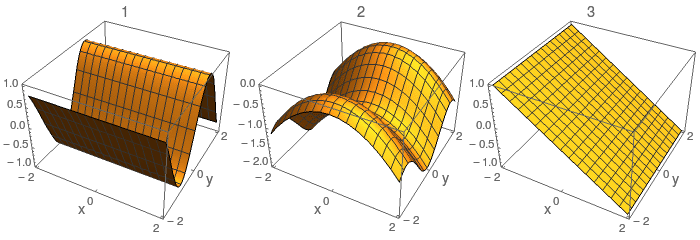Diferenças entre edições de "Gráficos derivadas parciais"
| Linha 8: | Linha 8: | ||
*LINGUA: pt | *LINGUA: pt | ||
*AUTOR: Equipa Calculo diferencial e integral 2 | *AUTOR: Equipa Calculo diferencial e integral 2 | ||
| − | *MATERIA PRINCIPAL: | + | *MATERIA PRINCIPAL: Derivadas parciais |
*DESCRICAO: | *DESCRICAO: | ||
*DIFICULDADE: easy | *DIFICULDADE: easy | ||
Revisão das 15h51min de 25 de fevereiro de 2018
Metadata
- CONTEXTO : Primeiro ciclo universitário
- AREA: Matemática
- DISCIPLINA: Calculo diferencial e integral 2
- ANO: 1
- LINGUA: pt
- AUTOR: Equipa Calculo diferencial e integral 2
- MATERIA PRINCIPAL: Derivadas parciais
- DESCRICAO:
- DIFICULDADE: easy
- TEMPO MEDIO DE RESOLUCAO: 15 mn
- TEMPO MAXIMO DE RESOLUCAO: 30 mn
- PALAVRAS CHAVE:
De seguida estão representados três gráficos, numerados de 1 a 3. Um é o gráfico duma função escalar nas duas variáveis reais x e y, da forma \(\text{f}\left(\begin{array}{c}x\\y\\\end{array}\right)=\text{f}_1\text{(x)+}\text{f}_2\text{(y)}\), outro é o gráfico da derivada parcial em ordem a x dessa função e o outro da derivada parcial em ordem a y da mesma função.
Qual a correspondência correcta?
A)1 corresponde a \(\text{f}\left(\begin{array}{c}x\\y\\\end{array}\right)\) , 2 corresponde à derivada \(\text{D}_1\text{f}\left(\begin{array}{c}x\\y\\\end{array}\right)\) e 3 corresponde à derivada \(\text{D}_2\text{f}\left(\begin{array}{c}x\\y\\\end{array}\right)\)
B)1 corresponde a \(\text{f}\left(\begin{array}{c}x\\y\\\end{array}\right)\) , 3 corresponde à derivada \(\text{D}_1\text{f}\left(\begin{array}{c}x\\y\\\end{array}\right)\) e 2 corresponde à derivada \(\text{D}_2\text{f}\left(\begin{array}{c}x\\y\\\end{array}\right)\)
C)2 corresponde a \(\text{f}\left(\begin{array}{c}x\\y\\\end{array}\right)\) , 1 corresponde à derivada \(\text{D}_1\text{f}\left(\begin{array}{c}x\\y\\\end{array}\right)\) e 3 corresponde à derivada \(\text{D}_2\text{f}\left(\begin{array}{c}x\\y\\\end{array}\right)\)
D)2 corresponde a \(\text{f}\left(\begin{array}{c}x\\y\\\end{array}\right)\) , 3 corresponde à derivada \(\text{D}_1\text{f}\left(\begin{array}{c}x\\y\\\end{array}\right)\) e 1 corresponde à derivada \(\text{D}_2\text{f}\left(\begin{array}{c}x\\y\\\end{array}\right)\)
E)3 corresponde a \(\text{f}\left(\begin{array}{c}x\\y\\\end{array}\right)\) , 1 corresponde à derivada \(\text{D}_1\text{f}\left(\begin{array}{c}x\\y\\\end{array}\right)\) e 2 corresponde à derivada \(\text{D}_2\text{f}\left(\begin{array}{c}x\\y\\\end{array}\right)\)
F)3 corresponde a \(\text{f}\left(\begin{array}{c}x\\y\\\end{array}\right)\) , 2 corresponde à derivada \(\text{D}_1\text{f}\left(\begin{array}{c}x\\y\\\end{array}\right)\) e 1 corresponde à derivada \(\text{D}_2\text{f}\left(\begin{array}{c}x\\y\\\end{array}\right)\)
Para obter o zip que contém as instâncias deste exercício clique aqui(graficosDP)
Se deseja obter o código fonte que gera os exercícios contacte miguel.dziergwa@ist.utl.pt
